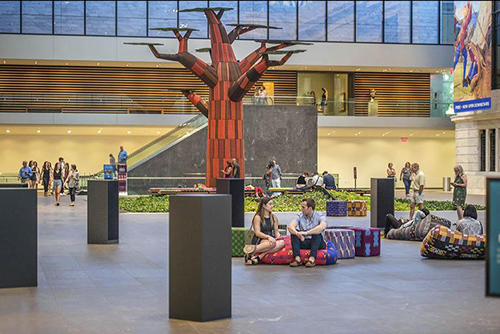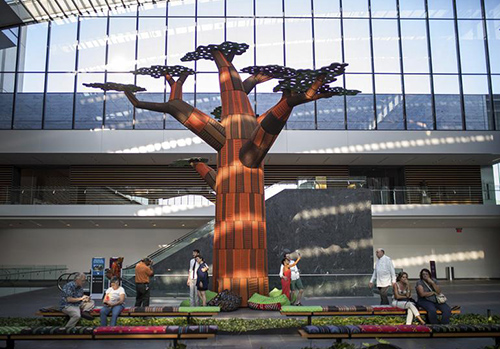by Mike Telin

After spending time in the Atrium and observing how it functions as a gathering place for social activities, he began to think, “why don’t I bring something to Cleveland from Nigeria?” adding that if he had made his first visit in the summer “it would have been a different piece.”
If you have not had the opportunity to experience Ámà: The Gathering Place, you have a few more weeks to do so — the exhibit will remain on display through the first of December. Commissioned for the Atrium, the installation uses sound, sculpture, and textiles that capture the sense of a village square reminiscent of Ogboh’s birthplace in Enugu.
For the music, Ogboh chose twelve Igbo folk songs that have been arranged specifically for the exhibit. “The songs are traditional and have been around for many years,” he said. “I chose some that are popular, some that remind me of my childhood, and others that have contemporary themes.”
The songs were recorded in Nigeria in the Igbo language by members of the J Clef Choral, which is based in the eastern part of the country. “Choirs are usually recorded as a group in stereo format,” he explained, “but for the sound installation I wanted to isolate each voice, so each member of the choir was in a separate booth.”

The sound is transmitted wirelessly to the speakers. “Inside each box is a speaker, a wireless receiver, and a battery pack. It was tricky but it worked out well. The guys at the Museum came up with that brilliant solution, I can’t take that honor.”

Emeka Ogboh said that he is quite happy with Ámà: The Gathering Place. “I’m very proud of it. It’s probably the best work I’ve done so far.”
Ogboh has participated in numerous international exhibitions, including documenta 14 (2017); Skulptur Projekte Münster (2017); the 56th edition of La Biennale di Venezia (2015); and Dakar Biennale (2014). In 2014 he was selected to create a public commission for the new Peace and Security building of the African Union in Addis Ababa. He was a finalist for the 2018 Hugo Boss Prize, and in 2016 he was awarded the Prize of the Bottcherstraße in Bremen. Ogboh is currently one of the inaugural fellows at Columbia’s Institute for Ideas and Imagination in Paris.
Published on ClevelandClassical.com November 7, 2019.
Click here for a printable copy of this article



